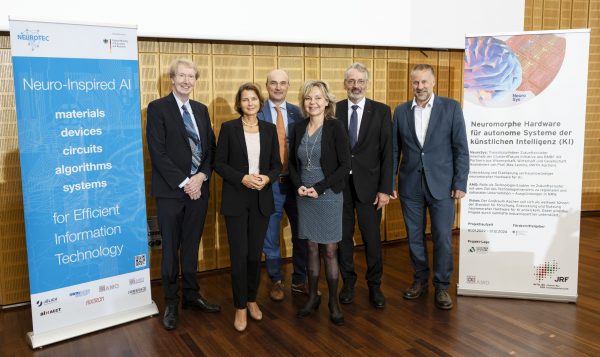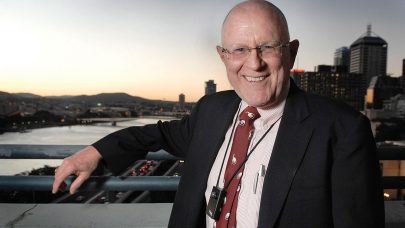Sept. 1, 2023 — They could be the key to meeting the growing appetite for energy of artificial intelligence (AI): neuro-inspired computer chips modeled on the human brain. Researchers at Forschungszentrum Jülich and RWTH Aachen University are driving the technology forward in the NEUROTEC project and the NeuroSys cluster. At this week’s Jülich-Aachen Neuromorphic Computing Day, scientists, together with partners from high-tech companies and start-ups, gave around 200 guests insight into the latest developments.

Prof. Sabine Döring, state secretary at the German Federal Ministry of Education and Research (BMBF), stated: “We aim to drive structural change in the Rhenish mining area through research and innovation. In this way, we also help to maintain and create added value and employment in the regions affected. The NEUROTEC project shows how this can be achieved: By building a strong network of science and industry, the microelectronics of the future will be promoted and the transfer to industry accelerated.
“Through NEUROTEC and the NeuroSys cluster, the greater Aachen area will become one of the leading locations for European AI hardware. This is because neuromorphic chips, such as those being developed as part of NEUROTEC and NeuroSys, can significantly reduce the resources required for AI in the future. However, successful structural change can only succeed if we also manage to transfer scientific findings into practical applications. NEUROTEC and NeuroSys offer optimal conditions for this and thus for a new, innovative AI hub in the Rhenish mining area.”
In computing centers in Germany and around the world, the demand for electricity has continuously increased over the years. The use of AI is considered one of the drivers of this development. ChatGPT and similar applications are increasingly displaying human-like capabilities. But the computers, on which the applications run, function quite differently from a biological brain. The difference is also reflected in the energy consumption: Supercomputers require similar amounts of electricity to train artificial neural networks as a relatively small city. The human brain, in contrast, requires no more than the energy of a 25-watt light bulb to function.
“Neuromorphic systems, which are based on the functioning of the human brain, promise to train and operate such AI processes much more efficiently – by several orders of magnitude – than is possible with conventional digital computers,” explains Prof. Astrid Lambrecht, Chair of the Board of Directors of Forschungszentrum Jülich. “This technology is a real key innovation. Neuromorphic computing is an interdisciplinary research field par excellence that could not thrive without the networking of neuroscience, physics, electronics, computer science, and materials science as practised here at Forschungszentrum Jülich and in collaboration with our partners. Potential applications range, for example, from intelligent implants in medicine and pattern recognition in smartphones and other mobile devices to the use of AI in industry, in the agricultural sector, and for autonomous driving.”
Forschungszentrum Jülich and RWTH Aachen University are regarded as the best in the world when it comes to research into memristive materials and components, which are key elements for building a neuromorphic computer. Memristive components can store and process information as artificial synapses in neural networks.

However, NEUROTEC goes beyond pure research. In cooperation with high-tech companies in the region such as the system manufacturer AIXTRON, the measurement technology specialist aixACCT Systems GmbH, and the nanotechnology companies AMO GmbH and SURFACE systems+technology GmbH & Co. KG, a novel, comprehensive basic technology for neuromorphic AI is being created, and technological know-how gained through research is being transferred directly to – primarily regional – industry. The collaborative project entered its second phase in 2021 and receives funding of € 36 million from BMBF’s funds for structural change over a five-year period.
“The first results will already be available in the next generation of automotive electronics. This involves energy-saving and fast ReRAM memories from Infineon and TSMC that can store information permanently without continuous power supply. They were optimized using test and programming procedures from NEUROTEC,” says NEUROTEC coordinator Prof. Rainer Waser from Forschungszentrum Jülich and RWTH Aachen University.
The actual goal of the project, which is to implement the first neuromorphic demo chips for practical applications, is also becoming more and more achievable. “We have already conducted extensive experiments with chips based on 180-nm semiconductor technology, and have made minor, yet important, progress. For example, we are investigating how reliably these new types of components can be manufactured using CMOS technology, or whether they still work without errors after many switching cycles,” says Prof. Rainer Waser.
The first designs based on the more modern 28-nm technology went into production in Taiwan at the end of May. After further processing and assembly with memristive elements from Jülich-Aachen research, they will soon be tested with the first real applications, for example with procedures for route optimization, computer virus searches in the data stream, or artificial neural networks at hardware level for deep learning.
In addition, researchers from RWTH Aachen University and Forschungszentrum Jülich are collaborating with companies in the region as part of the NeuroSys cluster to tap into further market and application potential.
“Neuromorphic computing will open up a variety of possibilities for using energy-efficient AI applications in speech, image, and video processing, as well as medicine. RWTH Aachen University is also thinking on a large scale here and offers its wealth of experience regarding the translation of research findings. Together with associations such as the Aachen Chamber of Industry and Commerce and Zukunftsagentur Rheinisches Revier, various scenarios are being explored for the further development of our innovation ecosystem, right up to the establishment of a factory for computer chips ‘made in NRW’,” explained Prof. Ulrich Rüdiger, rector of RWTH Aachen University.

The Aachen and Jülich region has much to offer too. In addition to the renowned research institutions, the region is home to high-tech companies such as AIXTRON, aixACCT, Surface, Sympuls, X-Fab, and ELMOS, which are active in the strategically important field of semiconductors, as well as start-up initiatives such as NEUREKA (RWTH) and AiML (FZJ), both of which were funded by the SPRIND agency as part of the New Computing Concepts Challenge, and the start-up Black Semiconductor (AMO), which is involved in the planned second IPCEI project on microelectronics and communications technology.
“Our research covers the entire value chain, including societal and ethical issues always raised by disruptive technologies. This offers opportunities on many technological levels for regional companies and start-ups to accelerate structural change. We are already seeing the first effects on the labour market and corporate investment. In the long term, semiconductor manufacturing in the region would ideally complement the existing comprehensive and internationally renowned expertise and infrastructure, and further increase the attractiveness of the region for the extremely well educated individuals from Forschungszentrum Jülich and RWTH Aachen University,” said NeuroSys Coordinator Prof. Max Lemme from RWTH Aachen University and Managing Director at AMO GmbH.
The Jülich Supercomputing Centre (JSC/FZJ) is also an ideal development partner for testing neuromorphic modules in the field of high-performance computing. Together with industrial partners, JSC operates and develops state-of-the-art supercomputers with the highest possible level of performance for research. In 2024, Europe’s first exascale supercomputer will be launched there.
Source: Forschungszentrum Jülich/Jülich Supercomputing Center


























































